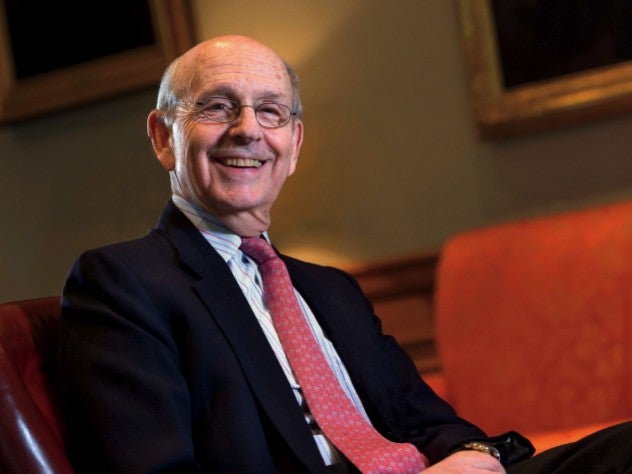Justice Stephen G. Breyer, LL.B. ’64, sometimes says that his job and that of other members of the Supreme Court is to speak for the law. He does not mean that justices are Platonic Guardians, with ironclad power to impose their will on the nation despite being unelected. The job calls for deference to the elected branches of government, he emphasizes, and, even more, for caution and doubt. The United States is built on the principles of liberty, he quotes from a famous speech by Judge Learned Hand, and liberty’s spirit is “the spirit which is not too sure that it is right.”
At 78 and on the Court since 1994, Breyer is often described as a pragmatist whose vote in a case is influenced by the real-world consequences of deciding for one contending party versus the other. He is less predictable and sometimes more conservative — more of a moderate — than the three other justices with him in the Court’s liberal wing, Ruth Bader Ginsburg, Sonia Sotomayor, and Elena Kagan. Some of their liberal opinions have sparked celebrity for each of them. Breyer has inspired no similar following.
He is best known as a sparring partner of the late Justice Antonin G. Scalia. Beginning in 1991 — when Scalia had been on the Supreme Court for just five years and Breyer was the chief judge of the U.S. Court of Appeals for the First Circuit, in Boston — and continuing for more than two decades, they argued in many events around the country about how each thought a judge should speak for the law.
By almost any measure, Scalia won that long series of encounters. The ideas that he championed were highly influential on legal conservatism as it ascended to prominence in the legal culture. Scalia delivered them with bluster and sometimes bullying, leavened with color and charm: his largeness and loudness were memorable, reinforcing the seeming forthrightness of his thinking. Breyer praised him as a “titan of law” after he died.
It was a victory on accumulated points, however, with no knockouts. Breyer’s geniality and moderation are the opposite of swagger — they reflect his counterview, which is measured and nuanced. He also began with a handicap: when they first debated, Scalia outranked him. But Breyer proposed a coherent jurisprudence as an alternative, which grew clearer over the years. He became the leading member of the Court to challenge Scalia about the role of the Court in American governance, the most important dispute in American law.
Their debates grew out of a technical-seeming yet deep-seated disagreement over laws passed by Congress. Scalia said he believed that Americans are governed by laws, not by the intentions of legislators, so drawing a law’s meaning from its development in Congress, he said, is unconstitutional. He was a “textualist,” in favor of finding the import of a statute only in its words and structure. Breyer agreed that a judge should do that when it is possible, but took what seemed to him the commonsensical position that, when the meaning of a statute is not clear from the words or their context, judges should read the law’s history as a valuable tool in figuring that out.
The debates expanded to address how to interpret the Constitution. Scalia expounded about “originalism,” the conservative view that the job of anyone applying America’s fundamental law—especially a justice—is to examine and employ what the Founders meant when they wrote it. Breyer’s reply was that, while it was admirable that Scalia sought to restrain himself by proceeding objectively, his method was less objective than he claimed. History often failed to provide clear guidance. Then what? Should the Court refuse to take a case because the record on how the eighteenth century thought about the issue was skimpy?
Scalia and Breyer also addressed the inescapable question about judicial review and the principle that the Supreme Court’s reading of the Constitution’s meaning is final, unless the Court reverses itself: Because justices are appointed, not elected, and they have life tenure, what keeps them from turning judicial review into judicial supremacy?
In the nineteenth century, the answer was, the Law. By the twentieth century, there was wide agreement that justices make law rather than finding it, so the law was no longer the restraint it was once said to be. That left the Court’s role as an institution of government as the best alternative: to retain their authority, justices needed to be self-restrained, deferring as much as possible to the democratically elected representatives in Congress, the White House, and the states. In the past generation, though, no one has seriously viewed the Court as a model of restraint. A wide majority of Americans say the justices are often influenced by their political views.
Breyer insists that justices are not “junior-varsity politicians,” second-guessing Congress and the president. But he says this because he knows many people are convinced they are. In an era when it has been smart politics to attack government itself, his project has been to explain “the Supreme Court’s role in maintaining a workable constitutional system of government” (his italics).
Read the full feature in the March-April 2017 issue of Harvard Magazine.
Lincoln Caplan ’72, J.D. ’76, a contributing editor, is visiting lecturer in law at Yale Law School and the author of six books about the law, most recently American Justice 2016: The Political Supreme Court. He wrote about the Court as a New Yorker staff writer and as a member of the editorial board of The New York Times. His recent Harvard Magazine articles have covered Professor Cass Sunstein [6] (January-February 2015), Judge Richard Posner [7] (January-February 2016), and sibling scholars Carol Steiker and Jordan Steiker and their scholarship on the death penalty [8] (November-December 2016).
